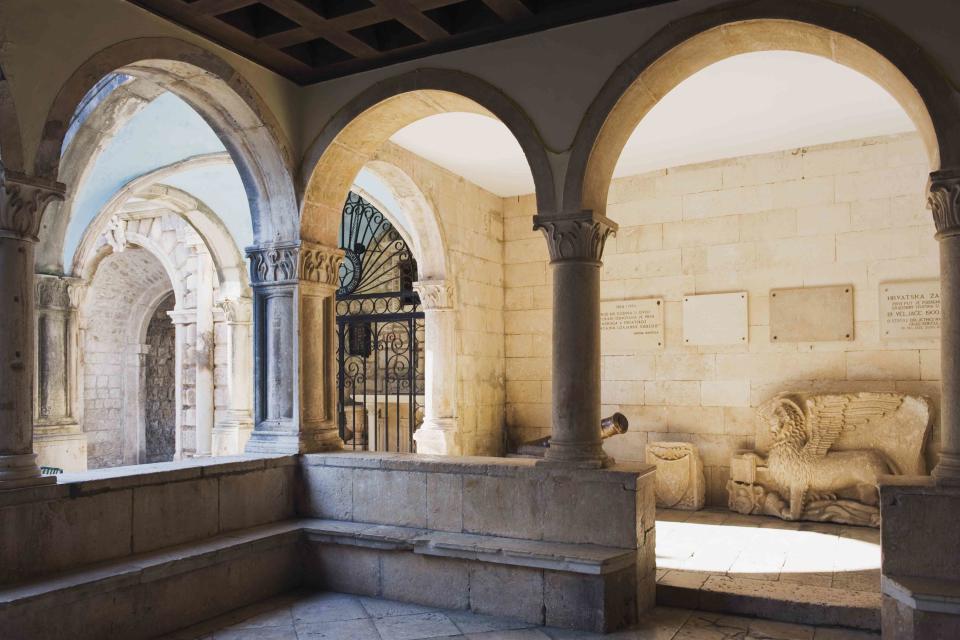What Is a Loggia?
An Upscale Word for Porches and Covered Patios

Fact checked by Sarah Scott
While you probably won't find a porch in Europe, you will find something similar called a loggia. A loggia is an Italian word for a covered outdoor corridor or gallery usually attached to the main residence. The space would typically incorporate architectural columns and arches into its design. The Oxford Dictionaries further describe a loggia as "a gallery or room with one or more open sides, especially one that forms part of a house and has one side open to the garden." Its origin is from the mid-18th century from the Italian word for "lodge." The term is somewhat antiquated and most often associated with older European buildings, such as the Royal Albert Hall, a concert hall that has loggia box seating.
Benefits of a Loggia
Loggias can function like porches but these outdoor spaces can be even more beneficial to your home. A loggia designed with old-world flair can do the following:
Adds an elegant and grand architectural feature to a home
Provides a perfect shady and private spot for alfresco dining
Offers a seamless transition from indoor to outdoor space
Accommodates multiple outdoor seating areas
History of Loggias
Loggias debuted during the Italian Renaissance in the tropical Mediterranean region where an open room with sun protection was necessary for comfort. Some loggias faced a central courtyard which made the airy spaces easily accessible from inside the home. Lengthy loggias allowed for strolling, sitting, and dining in both residential and commercial structures. One of the most famous loggias is the Loggia dei Lanzi, also called the Loggia della Signoria, located in Florence, Italy. Built in the 14th century, it features wide arches and Corinthian columns and is open to the street.
Loggias in Contemporary Design
When used in contemporary architectural, interior, or landscape design, the word loggia sometimes ends up being whatever the designer—or client—wants it to be.
Some designers tout "loggia rooms" that combine Italian architecture with old-world craftsmanship for a Mediterranean look. These loggia rooms generally have an open-air outer wall that's supported by columns to give it that perfect classical touch. Loggias can further tap into their Italian or Greek roots with materials, such as brick, stone, steel, glass, and genuine marble.
Disadvantages of Loggias
Loggias are lovely but they won't shelter you or your furnishings from wind and other elements of weather. In addition, loggias require the same level of cleaning and maintenance as do structures like porches, covered patios, and decks.
The Loggia Test
A true loggia has distinct architectural features that set it apart from other rooms, structures, and outdoor spaces. Key traits of a loggia include the following:
It is traditionally located on the lower or ground level of a home.
It projects or is built out from the house toward the front or back garden or into a courtyard.
At least one wall connects to the main structure.
It is supported by columns and arches (colonnades), which provide detail, privacy, and shelter.
When a loggia faces a courtyard, it is only accessible via the interior of the house. In other words, you first have to go inside the structure to eventually go outside onto the loggia.
An important purpose of a loggia is to allow air to circulate throughout the house.
Notable Buildings With Loggias
If you're determined to build a true loggia, look to the masters for guidance and inspiration. Aside from the Loggia dei Lanzi (Loggia della Signoria), other notable buildings that have loggias include:
The Armstrong Kessler Mansion in Savannah, Georgia, was built in 1917, and its Italian Renaissance Revival style includes a loggia.
The Loggia del Mercato Nuovo, also known as the Loggia del Porcellino, is a building in Florence, Italy.
La Loggia restaurant, Villa San Michele, is in Fiesole, Florence, Italy.
The Sydney Opera House added a loggia to its western side that opened in 2006.
Stanford University in Stanford, California, features loggias on its main quad.
Edificio La Inmobiliaria in Buenos Aires, Argentina, has a loggia.
Carnegie Mellon University in Pittsburgh has loggias that frame a quad known as The Cut.

